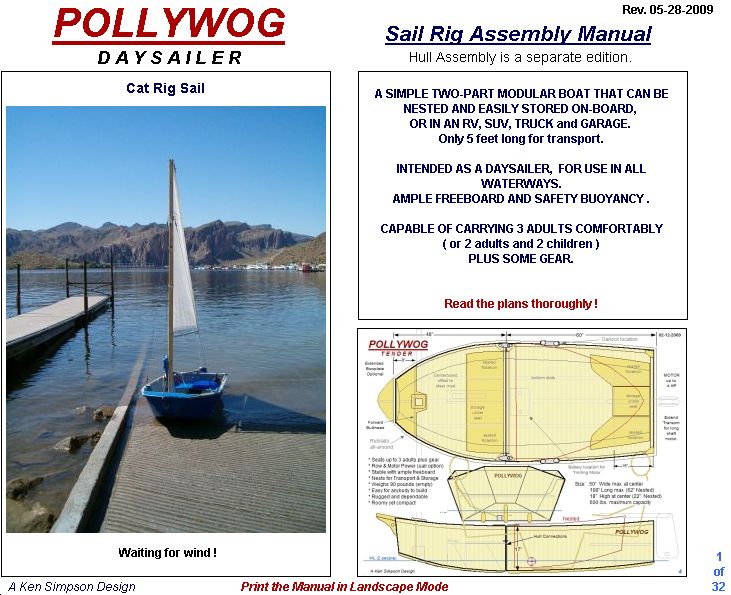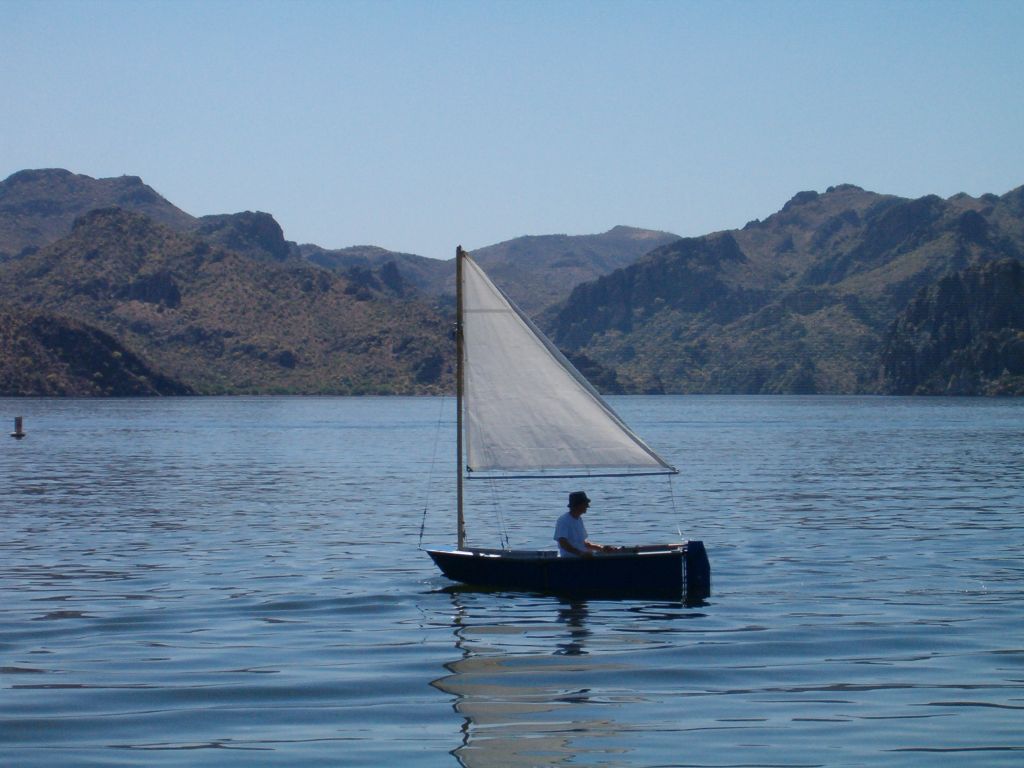POLLYWOG SAIL is the sailboat version of Pollywog. The primary feature is that all sail gear stores in the hull for transport, including the unique collapsible mast ! Talk about portable.
July 2011. A NEW Folding Mast & Boom design is available for the POLLYWOG. It does not require Mast Stays, and is therefor simpler to raise and lower. It stores in the vehicle, but not in the boat, as does the standard mast. The choice is yours. Click the link below to review the design, and determine if it suites your needs.

|
PW FoldMast.pdf Size : 48.095 Kb Type : pdf |

Pollywog under a light wind.

All rigging, mast and boom stored in main hull for transport

Video of Pollywog under high wind sailing conditions.
POLLYWOG SAIL Design Overview
6/02/09
POLLYWOG UNDER SAIL
Well, I finally had a windy and challenging day at the lake with the sailing Pollywog. After waiting at the ramp for 30 minutes to get the boat into the water (a busy day at the lake), I was blessed with good winds, and gusts, that tested my boating skills. I quickly learned a lot about the boat, the sail, and my abilities, or lack thereof.
The first thing discovered was the best seating position, but only after trying them all. Being alone in the boat was an advantage because I could easily make changes without question, or confusion. With a good, constant wind, and sitting in the center seat, I discovered that the bow had a tendency to plow the water. Changing to the aft seat corrected the problem. After thinking about the cause, I concluded that as the boat heels to one side, the shape of the hull in the water changes, causing the center of buoyancy to move aft. Moving weight aft (in this case me) is a logical correction. All further sailing was conducted from this position, or on the floor in front of the aft seat, the only problem being that my body was at times in the way of the tiller. I have yet to figure how to simplify this situation, other than to raise the tiller over my head, shift my position, and place the tiller on the other side, which I did many times. With regard to sailing with a partner, I suspect if one person were to sit in the center and the other aft, balance should be met, as the finished design of Pollywog differs from my prototype by increased stern curvature.
The next test came as the winds shifted, ceased completely, or gusted momentarily. Adjusting the sail for these conditions proved to be fairly easy, just let out the sheet, or pull it in. The location of the sheet on the tiller proved to be just right, everything at the ready. Sailing into the wind required a lot of thought however, while sailing downwind was a breeze (no pun intended). Tacking from side to side, attempting to go upwind, proved a challenge. The primary problem was to gain enough forward momentum to make a turn into the wind. Many times I was stalled in the process, and the sail just fluttered in the wind, the boat making no forward progress. Some boats do this better than others, and learning the technique for each boat takes time and patience. One good day of sailing is not going to resolve this, but I did determine that a gradual turn was easier to control, balancing the rudder with the sheet. My boating terms here may be lacking, but the feel of the boat is most important in deciding what move to make, and when. After a while, and many runs up the lake and back, I was able to turn at will. I guess more time at the tiller is required to answer all the questions that arise with a new boat.
The next challenge came in the form of strong winds and gusts. While going downwind, I was sometimes met with gusts that had a tendency to turn the boat. I had to compensate by pulling in the sheet, to maintain course. But the interim time was scary. The boat just took-off, on its own for a moment, and I was the hostage. Remember, the sail area is only 36 square feet on only a 12 foot high mast. This happened more than once, and a couple of times I let it go to see what the results would be. Although I never capsized the boat, it sure seemed to come close at times, with the water only a few inches from the gunwale. To me, the sail is a perfect size for the boat, and my inexperience. Hull speed is calculated to be about 6 knots, but with a strong wind it felt like I was sailing much faster. It was exciting, challenging and humbling all at the same time.
In conclusion, I must say I was impressed with all aspects of the little boat. It is rugged, roomy with plenty of freeboard, and able to withstand the inexperience of a novice sailor. Onlookers at the dock were intrigued by its ability to break-down completely into a package that fits into the bed of a small pickup, especially the nesting of the hull sections and the collapsible mast. The next trip out I hope will be with someone who can take a video of the assembly, launch and sailing of the Pollywog for the readers pleasure.
Best regards,
Ken Simpson
